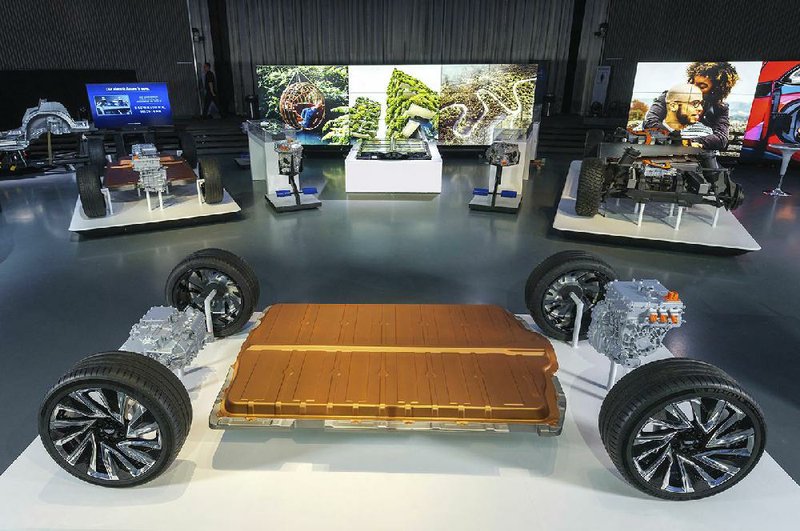General Motors unveiled plans to roll out an electric vehicle for every one of its brands starting this year, vowing the company will make money and have top-end range better than any Tesla Inc. model currently on the market.
New all-electric models will come from the Chevrolet, Cadillac, GMC and Buick brands starting this year, beginning with the Cadillac Lyriq luxury SUV to be unveiled in April.
A new Chevrolet Bolt small SUV will come in the summer of 2021. There's also the GMC Hummer electric pickup coming to dealers in the fall of 2021.
GM also has plans for three more Cadillac SUVs, a midsize Chevrolet SUV, two Buick SUVs, a GMC Hummer SUV, a Chevrolet full-size pickup, a luxury Cadillac car and the Cruise Origin, an autonomous electric shuttle.
The company touted an exclusive new battery technology it said could propel some of the vehicles as far as 400 miles on a single charge, more than the 390 miles Tesla now advertises for its top-end Model S. The battery packs will be branded Ultium and have pouch-style cells that can be stocked vertically or horizontally. Their design allows engineers to tailor batteries to different vehicle sizes and body styles.
At an event for investors, dealers and analysts at its sprawling technical center in the Detroit suburb of Warren, Mich., GM executives said the new vehicles would be built using modular chassis and drive systems for manufacturing simplicity.
Chief Executive Officer Mary Barra has been on a mission to remake GM -- once the largest automaker in the world -- by pulling the company out of regions where it underperformed and shutting down parts of the business that aren't making money. The savings wrought by those moves are freeing up resources to invest $20 billion into self-driving and electric vehicles by 2025.
"This is a historic moment for GM," Barra said Wednesday. "We will offer EVs from every brand, in every segment and every price point. The path we're on will get us to an all-electric future profitably."
With fewer parts than petroleum-powered vehicles, electric vehicles will be much cheaper and simpler to build, reducing manufacturing costs, GM said. The company plans 19 different battery and electric motor and transmission combinations.
The company said a joint venture with Korean battery maker LG Chem will use a low-cobalt chemistry to drive down battery costs to below $100 per kilowatt hour, the price at which GM has said electric vehicles will rival those of gasoline-powered cars.
At the technical center, GM President Mark Reuss revealed a long, hand-built Cadillac flagship sedan called Celestiq that's envisioned to be the brand's answer to Bentley. The idea is to make a statement that the struggling luxury division can build ultra-premium vehicles with the latest technology, he said.
"Do you think the Cadillac brand is in good shape? No, it isn't," Reuss said after the reveal. "But it will be. We will have a whole portfolio of new Cadillacs, one of which will be this transformational brand statement."
The keys to offering other models at lower prices will be battery chemistry and pack design. Cobalt is the most expensive commodity in a battery cell, and GM will reduce the use of it by 70%, said Andy Oury, lead engineer for GM's new packs.
The company also is working on a chemistry that has no nickel or cobalt that would eliminate the two most expensive ingredients for electric vehicle chemistry.
GM beat Tesla to the punch bringing out an affordable electric vehicle with more than 200 miles of range in 2016, a year ahead of the Model 3. But the company was said to expect to lose as much as $9,000 on each Chevy Bolt sold, and volumes have trailed well behind Tesla's cheapest sedan.
Tesla CEO Elon Musk's next model, the Model Y crossover, is now scheduled to start deliveries this month, getting a jump start on GM's new Cadillac.
For Barra's strategy to work, she will need to overcome some big challenges in the market. Tesla's brand is known for its with trendy electric vehicles. GM's brands are known more for their large SUVs and pickups that run on gasoline and diesel.
GM has more customers in the U.S. than anyone and high loyalty rates, she said, but they don't shop Chevy or Cadillac dealerships for electric vehicles.
Barra said companies have failed to beat Tesla because Musk's models have better range. If a car can't go 300 miles on a charge, sales will be limited. The current Bolt goes 259 miles on a charge and its sales have been modest.
As GM works with partners to build out charging infrastructure with a focus on cities and suburbs, it will help persuade existing customers to go electric and draw coastal city dwellers who don't buy GM's products, Barra said.
"We're solving the issues by making sure we have beautiful vehicles, making sure we have better range and developing workplace charging stations and making sure that people can afford the cars," she said. "We have assets that people aren't looking at to understand how we can win."
Information for this article was contributed by David Welch of Bloomberg News and by Tom Krisher of The Associated Press.
Business on 03/05/2020
